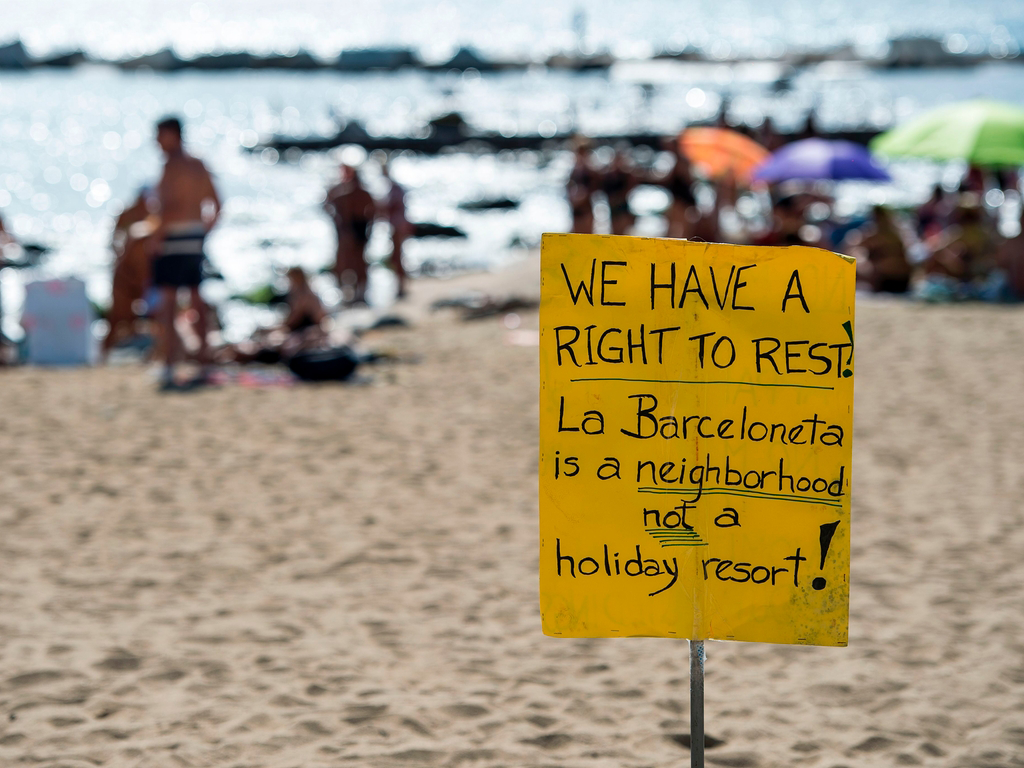Problem/Solution essay: Mass Tourism
The UN World Tourism Organisation states that tourism generates more than 2 trillion dollars annually and adds that tourism is now the primary source of foreign exchange, employment and cash in many parts of the world (UNWTO, 2016). Nevertheless, many now believe that mass tourism is damaging both for the environment and for a given destination’s cultural identity (Pollock, 2013). This is because factors such as overcrowding, overuse of scarce water and land resources results in many tourist destinations losing their beauty, charm and distinctiveness.
VIDEO: “Thai beach made famous by DiCaprio movie to close”
Source: Deutsche Welle (2018). Thai beach made famous by DiCaprio movie to close
Notes: turn on “Substitles/close captions” to read the transcript Duration: 02:57
Background reading
Too Many Guests: The Problems with Mass Tourism
Until very recently, international travel was a luxury for only the affluent or adventurous. However, since the middle of the twentieth century, the dream of seeing the world and visiting exotic locations has become more of a reality for a greater number of people due to rapid advances in technology and a dramatic rise in middle class populations. This greater access to international travel has many positive effects for both guests and hosts since traveling overseas allows many people to escape the stress and pressures of their everyday lives and create memories that will last them a lifetime, while tourism has become a booming business and major source of revenue for the local communities. Currently, international tourism makes up approximately 10% of the world’s economy with an estimated 1.6 billion international arrivals per year (Kummerer, 2018).
Although the aforementioned economic effects of tourism are very positive for the local places that people visit, in many cases these financial gains are only short term and they are causing some serious long-term negative effects on the local, host communities and the environment. When too many tourists visit the same location without proper management, the area becomes overcrowded and this results in many negative effects. In famous cites such as Venice and Barcelona, for example, the recent massive increase in tourists has upset local residents because living costs like rent have gone up exponentially, so many have been forced to move out of the city. Moreover, the old, narrow streets have become too crowded with tourist shops, so the locals are finding it more difficult to get to markets to buy daily necessities like food (Fisher, 2018). Aside from these negative effects on local residents, mass tourism can have a devastating impact on local ecosystems as well. For instance, in Thailand international arrivals have increased 123% since 2010, and this has had a disastrous effect on popular tourist destinations like Maya Bay, which has lost 80% of its marine life and had its coral reefs severely damaged by boats, divers and swimmers during this time period (Haines, 2018).
According to experts in the tourism industry, there are a few main reasons for the recent, dramatic growth in international travel. Firstly, since the early 2000s, there has been a big increase in the number of low cost airlines, which makes it cheaper for many people to travel more often. Likewise, between 2008 and 2016, the cruise ship industry exploded by 44%. Aside from these cheaper transportation costs, accommodation prices have gone down as well because of online companies like Airbnb. Furthermore, the rising affluence in countries such as China and India has resulted a greater number of people who can afford to travel internationally (Abend, 2018). Experts have also noticed that there has been a social change in people’s reasons for visiting certain destinations due to social media. According to Fisher (2018), before the rise in popularity of social media like Instagram and Facebook, most tourists visited a location to see it and have an experience there, but now many people travel to places where they want to be seen; taking a selfie photo at a famous spot and then uploading it to social media has become the main reason for the trip.
However, if this current trend of mass tourism to the same locations continues, it will have irreversible effects on the local communities and environment. In order to prevent this, many countries have been adopting solutions to make their popular tourist spots more sustainable. Some examples that have been introduced are restricting the number of tourists to a particular area, taxing them to visit that area, fining them for their behavior, and developing new ways to reduce tourists’ waste.
References
Abend, L. (July 26, 2018). Europe Made Billions from Tourists. Now It’s Turning Them Away. Time. Retrieved from, http://time.com/5349533/europe-against-tourists/
Deutsche Welle (2018, May 31). Thai beach made famous by DiCaprio movie to close. Deutsche Welle. Retrieved from, http://www.dw.com/en/thai-beach-made-famous-by-dicaprio-movie-to-close/av-44023277
Fisher, A. (2018, September 6). Are we killing tourist destinations for an Instagram photo? ABC News. Retrieved from, http://www.abc.net.au/news/2018-09-06/mass-tourism-proving-disastrous-is-instagram-to-blame/10198828
Haines, G. (2018, May 8). Our desire to see the world is killing it – here’s what you can do to help. The Telegraph. Retrieved from, http://www.telegraph.co.uk/travel/comment/tourism-carbon-emissions-how-to-help/
Kummerer, S. (2018, April 28). Eco-friendly tourism is becoming a movement, and more vacationers are buying into the concept. CNBC News. Retrieved from, https://www.cnbc.com/2018/04/27/eco-friendly-tourism-is-becoming-a-movement-and-more-vacationers-are-buying-into-the-concept.html
Pollock, A. (2013, August 21). Six reasons why mass tourism is unsustainable. The Guardian. Retrieved from,
https://www.theguardian.com/sustainable-business/six-reasons-mass-tourism-unsustainable
UNWTO (2016). Tourism Towards 2030. Madrid: United Nations World Tourism Organisation.




